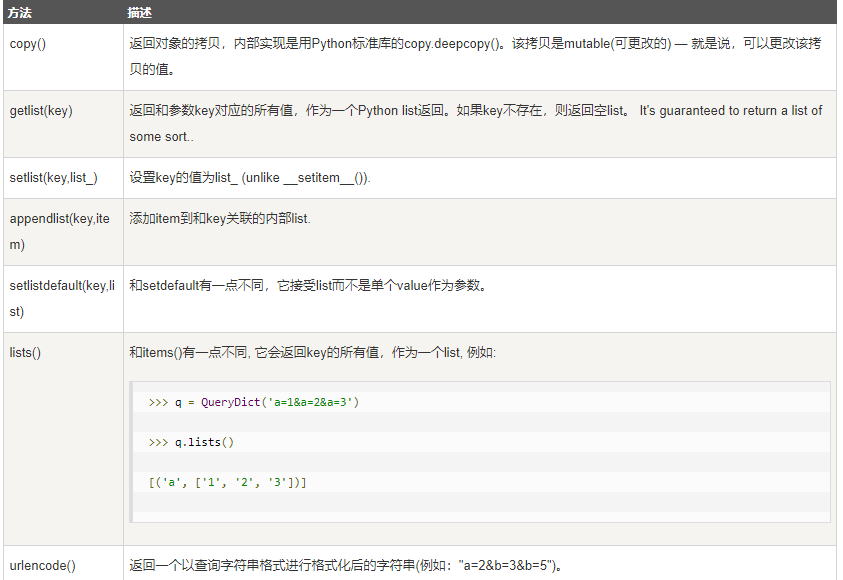HTML表单是网站交互性的经典方式。 用Django对用户提交的表单数据进行处理。 HTTP 请求 HTTP协议以"请求-回复"的方式工作。客户发送请求时,可以在请求中附加数据。服务器通过解析请求,就可以获得客户传来的数据,并根据URL来提供特定的服务。
GET 方法 在项目中创建一个 search.py 文件,用于接收用户的请求: /HelloWorld/HelloWorld/search.py 文件代码: # -*- coding: utf-8 -*- from django.http import HttpResponse from django.shortcuts import render_to_response # 表单 def search_form(request): return render_to_response('search_form.html') # 接收请求数据 def search(request): request.encoding='utf-8' if 'q' in request.GET and request.GET['q']: message = '你搜索的内容为: ' + request.GET['q'] else: message = '你提交了空表单' return HttpResponse(message)
在模板目录 templates 中添加 search_form.html 表单: /HelloWorld/templates/search_form.html 文件代码: <!DOCTYPE html> <html> <head> <meta charset="utf-8"> <title>(runoob.com)</title> </head> <body> <form action="/search" method="get"> <input type="text" name="q"> <input type="submit" value="搜索"> </form> </body> </html>
urls.py 规则修改为如下形式: /HelloWorld/HelloWorld/urls.py 文件代码: from django.conf.urls import url from . import view,testdb,search urlpatterns = [ url(r'^hello$', view.hello), url(r'^testdb$', testdb.testdb), url(r'^search-form$', search.search_form), url(r'^search$', search.search), ]
访问地址 http://127.0.0.1:8000/search-form 并搜索
POST 方法 上面使用了GET方法。视图显示和请求处理分成两个函数处理。 提交数据时更常用POST方法。下面使用该方法,并用一个URL和处理函数,同时显示视图和处理请求。 在 templates 创建 post.html: /HelloWorld/templates/post.html 文件代码: <!DOCTYPE html> <html> <head> <meta charset="utf-8"> <title>(runoob.com)</title> </head> <body> <form action="/search-post" method="post"> {% csrf_token %} <input type="text" name="q"> <input type="submit" value="Submit"> </form> <p>{{ rlt }}</p> </body> </html>
在模板的末尾,增加一个 rlt 记号,为表格处理结果预留位置。 表格后面还有一个{% csrf_token %}的标签。csrf 全称是 Cross Site Request Forgery。这是Django提供的防止伪装提交请求的功能。POST 方法提交的表格,必须有此标签。 在HelloWorld目录下新建 search2.py 文件并使用 search_post 函数来处理 POST 请求: /HelloWorld/HelloWorld/search2.py 文件代码: # -*- coding: utf-8 -*- from django.shortcuts import render from django.views.decorators import csrf # 接收POST请求数据 def search_post(request): ctx ={} if request.POST: ctx['rlt'] = request.POST['q'] return render(request, "post.html", ctx)
# -*- coding: utf-8 -*- from django.shortcuts import render from django.views.decorators import csrf # 接收POST请求数据 def search_post(request): ctx ={} if request.POST: ctx['rlt'] = request.POST['q'] return render(request, "post.html", ctx)
urls.py 规则修改为如下形式: /HelloWorld/HelloWorld/urls.py 文件代码: from django.conf.urls import url from . import view,testdb,search,search2 urlpatterns = [ url(r'^hello$', view.hello), url(r'^testdb$', testdb.testdb), url(r'^search-form$', search.search_form), url(r'^search$', search.search), url(r'^search-post$', search2.search_post), ] 访问 http://127.0.0.1:8000/search-post 显示
完成以上实例后目录结构为: HelloWorld |-- HelloWorld | |-- __init__.py | |-- __init__.pyc | |-- search.py | |-- search.pyc | |-- search2.py | |-- search2.pyc | |-- settings.py | |-- settings.pyc | |-- testdb.py | |-- testdb.pyc | |-- urls.py | |-- urls.pyc | |-- view.py | |-- view.pyc | |-- wsgi.py | `-- wsgi.pyc |-- TestModel | |-- __init__.py | |-- __init__.pyc | |-- admin.py | |-- admin.pyc | |-- apps.py | |-- migrations | | |-- 0001_initial.py | | |-- 0001_initial.pyc | | |-- __init__.py | | `-- __init__.pyc | |-- models.py | |-- models.pyc | |-- tests.py | `-- views.py |-- db.sqlite3 |-- manage.py `-- templates |-- base.html |-- hello.html |-- post.html `-- search_form.html
Request 对象 每个 view 函数的第一个参数是一个 HttpRequest 对象,就像下面这个 hello() 函数: from django.http import HttpResponse def hello(request): return HttpResponse("Hello world") HttpRequest对象包含当前请求URL的一些信息:
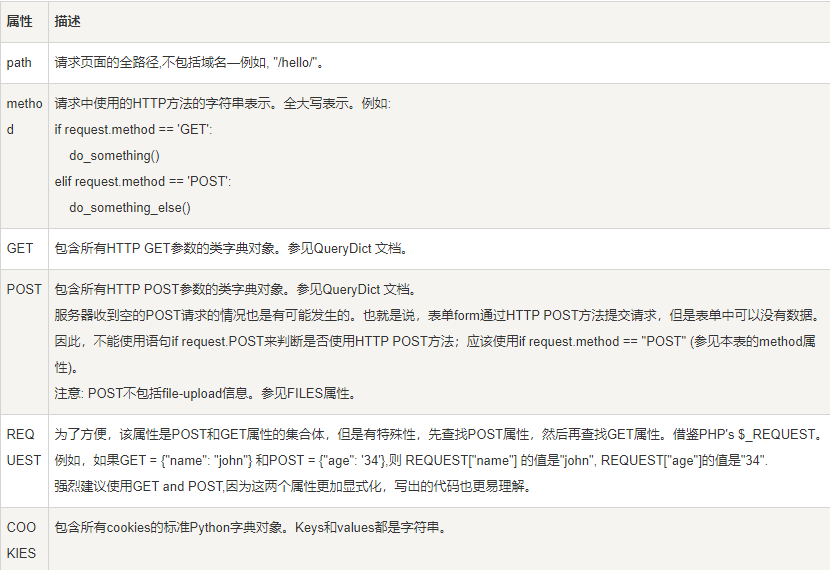

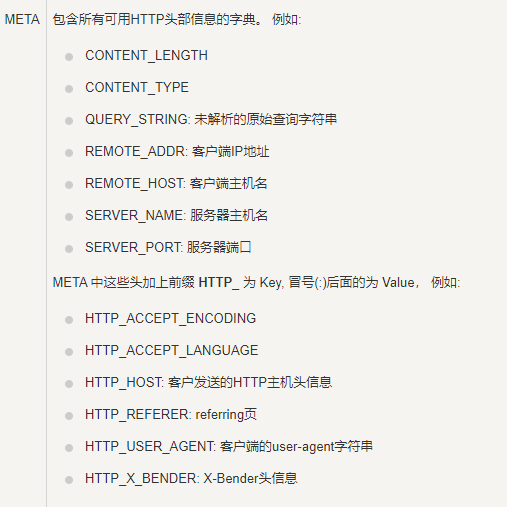
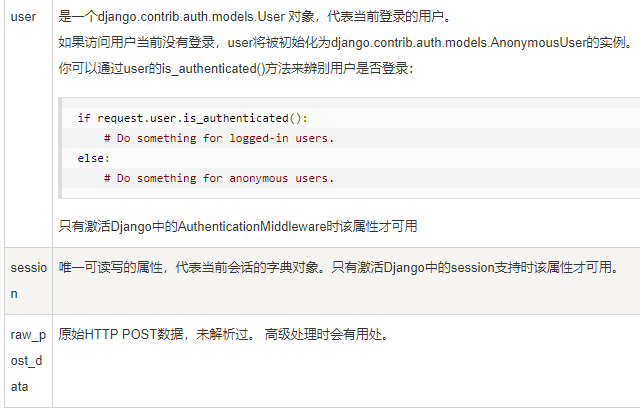
Request对象也有一些有用的方法:

QueryDict对象
在HttpRequest对象中, GET和POST属性是django.http.QueryDict类的实例。
QueryDict类似字典的自定义类,用来处理单键对应多值的情况。
QueryDict实现所有标准的词典方法。还包括一些特有的方法:

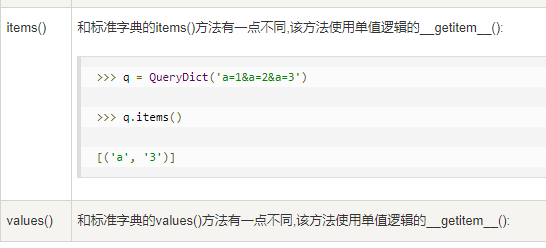
此外, QueryDict也有一些方法,如下表:
